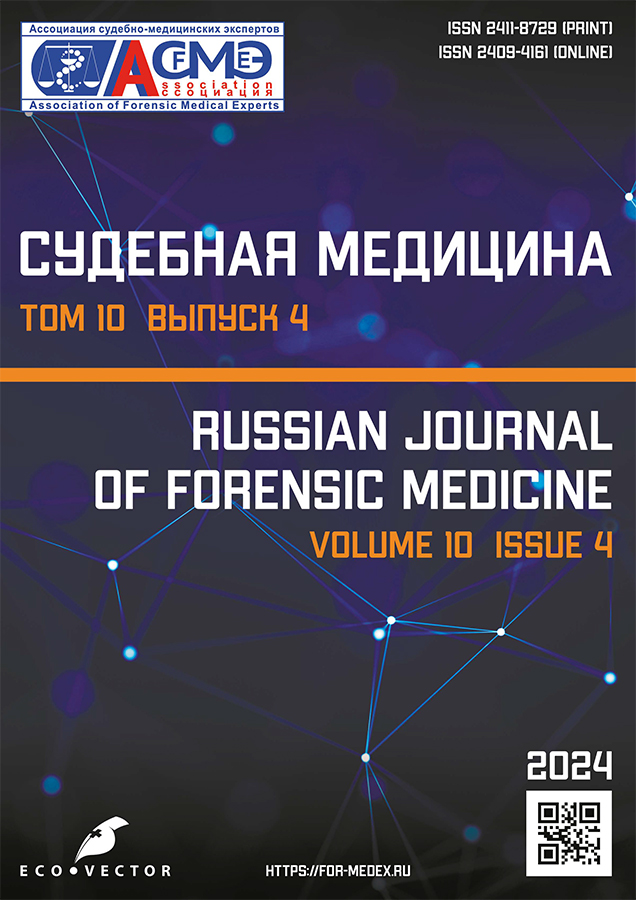在血液和尿液中检测生前摄入含蓖麻毒素的物质的标志物
- 作者: Barsegyan S.S.1, Kalekin R.A.1,2, Volkova A.A.1,2, Orlova A.M.1
-
隶属关系:
- Russian Centre of Forensic Medical Expertise
- Peoples' Friendship University of Russia
- 期: 卷 10, 编号 4 (2024)
- 页面: 529-538
- 栏目: 原创研究
- ##submission.dateSubmitted##: 02.06.2023
- ##submission.dateAccepted##: 08.11.2024
- ##submission.datePublished##: 05.12.2024
- URL: https://for-medex.ru/jour/article/view/11244
- DOI: https://doi.org/10.17816/fm11244
- ID: 11244
- ##submission.retractionDate##: 22.07.2025
- ##submission.retractionreason##:
涉及文章中介绍的研究过程中发现的违反生物医学伦理的行为。作者无法确认研究方案是否在研究开始前获得了伦理委员会的批准。此外,作者也无法确认参与研究的人员是否仅为自愿(单独或由其法定代表)签署知情同意书参与研究的人员,或书面同意将其医疗数据用于科研目的的人员。
该刊物网站上的电子版原文已被修改(标注为重新标记),期刊编辑部不建议阅读或用于进一步研究。
撤回文章: Russian Journal of Forensic Medicine. 2025;11(2). DOI: 10.17816/fm16274
如何引用文章

详细
The article has been retracted. A notice of retraction of this article has been published in the journal at the URL: https//doi.org/10.17816/fm16274
背景。鉴定细胞毒性物质引发的急性和致命中毒仍然是法医鉴定领域的重要任务。蓖麻毒素是此类物质中毒性最强的代表,其进入人体后可能对健康造成不可逆的严重后果。
研究目的。开发一种快速分析方法,以检测生物样本中蓖麻毒素中毒的标志物,用于法医鉴定的相关目标和任务。
材料与方法。研究描述了优化分离蓖麻毒素标志物—蓖麻碱和蓖麻酸的条件。对血液和尿液中的提取进行了分析。采用现代色谱技术进行研究,包括高效液相色谱-串联质谱法 (HPLC-MS/MS)和气相色谱-串联质谱法(GC-MS/MS)。
结果。根据研究结果,开发了一种快速检测生物液体中蓖麻碱和蓖麻酸的方法,仅需200 μl样本。确定了蓖麻碱和蓖麻酸的色谱和质谱特性。研究表明,蓖麻植物(Ricinus communis)种子加工产品中含有毒性蓖麻碱,可能导致人体中毒。
结论。提出了基于色谱法的快速法医化学和毒理分析方法,包括高效液相色谱-串联质谱法(HPLC-MS/MS)和气相色谱-串联质谱法(GC-MS/MS)。该方法通过检测生物样本中的标志物—蓖麻碱和蓖麻酸,用于蓖麻毒素中毒的鉴定。
关键词
作者简介
Samvel S. Barsegyan
Russian Centre of Forensic Medical Expertise
Email: himija@rc-sme.ru
ORCID iD: 0000-0001-6234-4253
SPIN 代码: 1261-1536
Cand. Sci. (Pharmacy)
俄罗斯联邦, MoscowRoman A. Kalekin
Russian Centre of Forensic Medical Expertise; Peoples' Friendship University of Russia
编辑信件的主要联系方式.
Email: himija@rc-sme.ru
ORCID iD: 0000-0002-4989-3511
SPIN 代码: 2473-7421
Dr. Sci. (Pharmacy)
俄罗斯联邦, Moscow; MoscowAlla A. Volkova
Russian Centre of Forensic Medical Expertise; Peoples' Friendship University of Russia
Email: himija@rc-sme.ru
ORCID iD: 0000-0002-9882-2330
Cand. Sci. (Pharmacy)
俄罗斯联邦, Moscow; MoscowAlevtina M. Orlova
Russian Centre of Forensic Medical Expertise
Email: himija@rc-sme.ru
ORCID iD: 0000-0002-5419-1418
SPIN 代码: 7685-2315
Cand. Sci. (Pharmacy)
俄罗斯联邦, Moscow参考
- Savochenko AI, Filkova KI. Effects of ricin on human's body. Russian Military Medical Academy Reports. 2018;37(1 S1-2):187–190. EDN: LIQORY
- Chepur SV, Al-Shekhadat RI, Gogolevsky AS, et al. Molecular aspects of ricin cytotoxicity. Medline.ru. 2021;22:271–292. EDN: SEKKDZ
- Kalekin RA, Volkova AA, Orlova AM, et al. Forensic chemical and chemicotoxicological examination of ricin poisoning by the HPLC-MS/MS method. Forensic Medical Expertise. 2023;66(3):34–39. doi: 10.17116/sudmed20236603134
- Privalova EG, Mirovich VI. Fundamentals of phytotoxicology. Overview of plant objects. Elements of phytochemical analysis: A textbook. Irkutsk; 2018. 102 p. (In Russ).
- Arstamyan OM, Tkachishin VS, Aleksiichuk AYu. Modern poisonous substances as a terrorist threat to society. Emergency Medicine. 2016;(2):11–20. EDN: WIBVJD doi: 10.22141/2224-0586.2.73.2016.74730
- Melnichenko OG. Ricin as a possible bioterrorist weapon and its impact on the cardiovascular system. Student Bulletin. 2022;(10-3):24–25. (In Russ).
- Odinets SI. Biometric analysis of cotyledon leaves of castor seedlings. Scientific and Technical Bulletin of the Institute of Oilseed Crops NAAS. 2018;(26):60–71. EDN: YICOOC doi: 10.36710/ioc-2018-26-07
- Volkova AA, Kalekin RA, Orlova AM. Detection of Clobazam and its metabolite in urine by high performance liquid chromatography with tandem mass spectrometric detection in case of poisoning. Russian Journal of Forensic Medicine. 2022;8(4):47–55. EDN: SRKTYU doi: 10.17816/fm705
- Kalekin RA, Moskaleva NE, Volkova AA, et al. Determination of zaleplon and clobazam by high performance liquid chromatography — high resolution tandem mass spectrometry using Orbitrap technology. Forensic Medical Expertise. 2022;65(2):24–28. EDN: VDZNPF doi: 10.17116/sudmed20226502124
补充文件







